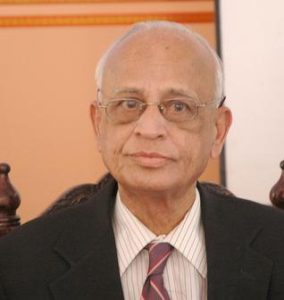Dr. P. K. Iyengar – probing atoms with a Nobel laureate

n October 1994, following announcement of the Nobel Prize in physics, there was celebration at the Babha Atomic Research Centre at Trombay.
The scientists had gathered to cherish their long association with Prof. Bertram N. Brockhouse of McMaster University of Canada — who shared Nobel Prize with Prof. Clifford Shull of Massachusetts Institute of Technology (MIT), USA, that year, and to felicitate the Professor.
When Prof. Brockhouse began his experiments which eventually led to his winning the Nobel Prize, there was an Indian scientist beside him — Dr. P. K. Iyengar. (Mr. Iyengar died on Wednesday.)
They soon co-authored a paper on the phonon spectrum of germanium. It was an extensive work on the quanta of lattice vibrations in Germanium. The paper became an instant hit as the as germanium was then the backbone of the transistor industry.
Dr. Iyengar left for India a few years later. But for several years since then, scientists from India’s fledgling atomic establishment used to visit Dr. Brockhouse and the Chalk River nuclear reactor facility of the Atomic Energy of Canada Limited where he worked.
Between 1957 and 1959, Dr. Brockhouse and Dr. Iyengar published five papers on the neutron spectrum of germanium and manganese compounds.
They had looked into almost every aspect of the phonon spectrum of germanium.
Until Dr. Brockhouse and Dr. Iyengar did their pioneering work in neutron spectrometry, the main tool used by scientists to probe the structure of materials was x-ray. Several Nobel prizes had been awarded for contributions in this area. [It was C. V. Raman, who discovered the scattering of light by liquids and crystals. This phenomenon, which later came to be known as the Raman Effect, could provide insights into the atomic structure of materials. When visible light or x-ray is scattered by liquids and solids, its frequency (energy) changes and scientists could deduce much about the structure of materials from these energy changes].
But x-ray has its limitations. The slow moving neutrons, on the other hand, has an advantage over x-ray in that the energy change they undergo on scattering was easy to measure. They were also sensitive to magnetic properties of atoms and neutron spectrometry was the only method by which one could look at the magnetism at the microscopic level. Dr. Shull made his mark in one area of neutron spectrometry dealing with neutron diffraction and Dr. Brockhouse in neutron inelastic scattering. Dr. Brockhouse studied the interaction of atoms in liquids and the lattice structure of crystals. Soon, he unravelled the secrets of spin dynamics, atomic motions in liquids and much more.
The studies by Brockhouse and Iyengar settled a virtual conflict in the theories propounded by Max Born and C. V. Raman regarding motion of atoms. Born held that there is a continuous distribution in frequencies of vibration of atoms while Raman postulated discreet frequencies. It was finally established through neutron spectrometry that the frequency distribution was continuous. Raman was looking at only a part of the spectrum.
Recalling his association with Dr. Brockhouse, Dr. Iyengar remembered that Dr. Brockhouse alone was working in the area of neutron inelastic diffraction at the time he joined him. They together did path breaking work in lattice dynamics of atoms. By trying to unravel the mysteries of atom using neutron as the probe, he attempted something that even Americans (with their penchant for risk taking) thought difficult.
Dr. Iyengar told this reporter back in 1994 that Brockhouse was an influence on him which orchestrated his Indian mind to assimilate the western research outlook. “I learned to how to look at physics which is to discover the laws of nature.”
The important thing was that a person who would not take a risk in attempting to make an innovation won’t do an innovation. “I could see how a Nobel Prize worthy experiment was being done.”
On his return to India, Dr. Iyengar took the lead for neutron spectrometric studies in India. “We had a fairly good group working on it at BARC and BARC hosted an international conference on neutron scattering in 1964. Dr. Brockhouse was also the inspiration behind the setting up of the research reactor Dhurva (in 1985),” Dr. Iyengar reminisced.
Ref: The Hindu






Leave a Reply